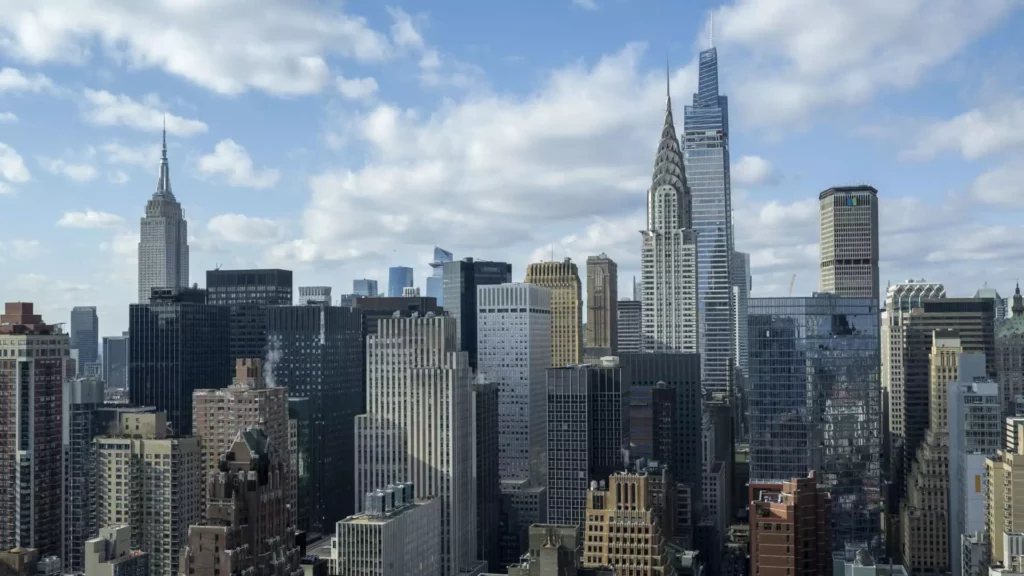In an ironic twist of fate, the post-pandemic landscape of New York City is breathing new life into its once-dormant office space market. After a tumultuous period marked by the rise of remote work and shifting employee dynamics, the demand for office spaces is not just returning; it has soared to pre-pandemic levels—up by a staggering 25% in the fourth quarter compared to the previous year. This increase signals a significant cultural and economic transformation, reflecting a resurgence in the creation of jobs that demand physical presence in the workplace, particularly in finance and technology.
The implications of this upturn are profound. Corporations, led by a mix of necessity and the realization that collaborative environments breed innovation, are actively encouraging their employees to return to the office. It is not merely a trend; it is a strategic maneuver to harness the innate creativity that can thrive only in face-to-face interactions. As Nick Romito, CEO of VTS, aptly points out, NYC’s workspace revival illustrates the city’s unique allure, rekindling its role as a global hub for innovation and collaboration.
SL Green Realty Corp, a key player in Manhattan’s real estate scene, provides an illuminating case study depicting this renaissance. While the company experienced revenue shortfalls recently, analysts are optimistic, predicting that tightening office supply in the city is sending demand into overdrive. SL Green CEO Marc Holliday’s projections suggest that the city’s economy is poised for a significant shift, with 38,000 new office-using jobs expected by 2025. This isn’t simply a matter of bodies filling up office chairs; it signals a robust return to office-centric work models which, despite debates around hybrid formats, seem to be gaining traction.
This development diverges starkly from remote work’s earlier allure which promised flexibility and work-life balance. The truth is that no virtual environment can replicate the serendipitous exchanges that occur in a physical office. Holliday’s insights emphasize that increasing on-site attendance reflects an undeniable demand for real spaces where relationships and networks can flourish. Optimism around office occupancy rates exceeding 93% in the coming year tightly aligns with this vision of a bright, collaborative future.
Undeniably, the recent decision by tech giant IBM to expand its presence at One Madison Avenue tells a compelling story of renewed confidence in New York’s business landscape. IBM’s growth is not just an economic statistic; it represents a cultural landmark where innovative ideas will converge within a vibrant work environment. Such expansions contribute to the broader narrative that New York is not merely bouncing back but actively positioning itself as a leader in the post-pandemic world of work.
Joanne Wright, IBM’s senior vice president for transformation and operations, recognizes the intrinsic value in fostering collaborative spaces. This reflects a fundamental truth: in an age of rapid technological advancement, humans crave connection. Trust in one another breeds innovation, and the decision to solidify IBM’s footing in NYC is more than just about real estate; it’s about investing in a future enriched by interaction and shared experiences.
While New York City undoubtedly shines as a beacon of recovery, other markets are showcasing variable growth. VTS indicates that San Francisco reported a remarkable growth rate of 32%. Yet, this surge emerges from a significantly depressed starting position. Both Seattle and Chicago also registered increases, albeit at a modest 15% each. In the grand national picture, overall demand was up by 12% in the fourth quarter.
What becomes fascinating in this context is how companies are reconceptualizing office space amid an evolving labor market. The willingness of businesses to invest in their physical spaces, driven by a renewed confidence, shatters expectations that suggested a downturn following the seasonal slump. This pivot reflects a mindset shift among companies—one that prioritizes long-term growth and workplace innovation over short-term cost-cutting measures.
In the broader narrative of work culture, the revival of office space demand in New York City intertwines with changing perceptions around the nature of employment itself. Despite the allure of flexible working arrangements, the palpable excitement of returning to an office—an environment rich with collaboration and spontaneous interactions—has inherent value that cannot be dismissed. This return to the office represents more than just physical space; it embodies a commitment to community, culture, and creativity, reaffirming New York City’s reputation as an indomitable force in the global economy. The future is clear, and it is time for the naysayers to recognize that the office is far from obsolete; rather, it is evolving into something more compelling and necessary than ever before.

